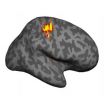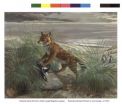"The finding is significant because it means that virus-host co-evolution after a genetic code shift can be more extensive than previously thought", said researcher Derek J. Taylor, professor of biological sciences at the University at Buffalo.
"It shows that these viruses can overcome what appears to be an insurmountable change in the host genome," Taylor said. "So the fact that we haven't previously seen any viruses in these species with a modified genetic code may not be because the viruses can't adapt to that shift. It may be that we haven't looked hard enough."
The study, titled "Virus-host co-evolution under a modified nuclear genetic code," was published on Tuesday, March 5th in PeerJ, a peer-reviewed, open-access journal in which all articles are freely available (https://PeerJ.com). The team of scientists, all from the University of Buffalo, discovered the highly adapted virus — a totivirus — in the yeast species Scheffersomyces segobiensis (a distant relative of human pathogens in the genus Candida).
In most living things, the genetic code comprises 64 elements called codons, most of which instruct the body to produce a certain amino acid, the basic building block of a protein. In S. segobiensis, however, the genetic code has been modified - a codon that usually stands for the amino acid leucine codes instead for serine (an amino acid change that can affect how proteins function). It had been thought that such a radical change in the genome may help host species evade viruses.
However, the presence of the totivirus in S. segobiensis shows that viruses may be more nimble than previously thought, able to overcome even this enormous hurdle. Intriguingly, the totivirus the researchers discovered has only one C-U-G codon left in its genome, suggesting that it may have purged that sequence as it adapted to the yeast host.
The research team found other odd and interesting evidence pointing to a history of co-evolution between totiviruses and yeasts with the modified code. For instance, the modified yeasts appeared to have incorporated genetic material from totiviruses into their genomes on at least four occasions. In total, evidence was found of past, or present, viral infection in five lineages of yeasts with a modified genetic code.
In the yeast Scheffersomyces stipitis, the scientists even identified a former totivirus gene that the host is now using to produce a protein.
"It's a non-retroviral RNA virus gene being kidnapped and expressed as a protein by a cellular host in the absence of a current viral infection" Taylor said. The function of this protein is unknown, but the result is further evidence of the unexpected co-evolution between viruses and hosts with modified nuclear code.
### EMBARGOED until Mar 5th 2013: 7 am EST; 12 midday UK time
Link to the Published Version of the article: (quote this link in your story – the link will ONLY work after the embargo lifts): https://peerj.com/articles/50 - your readers will be able to freely access this article.
This article is published in PeerJ, a newly launched (on Feb 12th) Open Access Journal. There is a separate Press Release for the PeerJ launch, at: http://bit.ly/PeerJPR02052013
Competing Interests Statement (from the article): "The authors declare no competing interests."
Funding Statement (from the article): "Sequencing and material support was provided by the University at Buffalo. The funders had no role in study design, data collection and analysis, decision to publish, or preparation of the manuscript."
Handling Academic Editor (conducted the peer review and approved the publication): Gerard Lazo, USDA, Western Regional Research Center, USA.
Peer Reviews: PeerJ encourages authors to publish the peer reviews, and author rebuttals, for their article. For the purposes of due diligence by the Press, we provide these materials as a PDF at the following link (this link will NOT work after the embargo lifts – after that time the review comments will be accessible via the live article URL noted above): http://bit.ly/TaylorPeerJReviews
Citation to the article: Taylor et al. (2013), Virus-host co-evolution under a modified nuclear genetic code. PeerJ 1:e50; DOI 10.7717/peerj.50
Co-authors: Professor Taylor's co-authors on the study are UB PhD candidate Matthew Ballinger, former UB postdoctoral researcher Shaun M. Bowman, and UB Professor Jeremy Bruenn, all in UB's Department of Biological Sciences.
About PeerJ
PeerJ is an Open Access publisher of scholarly scientific content, which offers researchers a lifetime membership, for a single low price, giving them the ability to openly publish all future articles for free. The launch of PeerJ occurred on February 12th, 2013 with the publication of 30 articles. PeerJ is based in San Francisco, CA and London, UK and can be accessed at https://peerj.com/.
All works published in PeerJ are Open Access and published using a Creative Commons license (CC-BY 3.0). Everything is immediately available—to read, download, redistribute, include in databases and otherwise use—without cost to anyone, anywhere, subject only to the condition that the original authors and source are properly attributed.
PeerJ Media Resources (including logos) can be found at: https://peerj.com/about/press/
Media Contacts
For the Authors:
Professor Derek Taylor, +1 (716) 645-2880., djtaylor@buffalo.edu
For PeerJ:
press@peerj.com +1 415 413 4596 (PST) https://peerj.com/about/press/
Abstract (from the article)
Among eukaryotes with modified nuclear genetic codes, viruses are unknown. However, here we provide evidence of an RNA virus that infects a fungal host (Scheffersomyces segobiensis) with a derived nuclear genetic code where CUG codes for serine. The genomic architecture and phylogeny are consistent with infection by a double-stranded RNA virus of the genus Totivirus. We provide evidence of past or present infection with totiviruses in five species of yeasts with modified genetic codes. All but one of the CUG codons in the viral genome have been eliminated, suggesting that avoidance of the modified codon was important to viral adaptation. Our mass spectroscopy analysis indicates that a congener of the host species has co-opted and expresses a capsid gene from totiviruses as a cellular protein. Viral avoidance of the host's modified codon and host co-option of a protein from totiviruses suggest that RNA viruses co-evolved with yeasts that underwent a major evolutionary transition from the standard genetic code.




